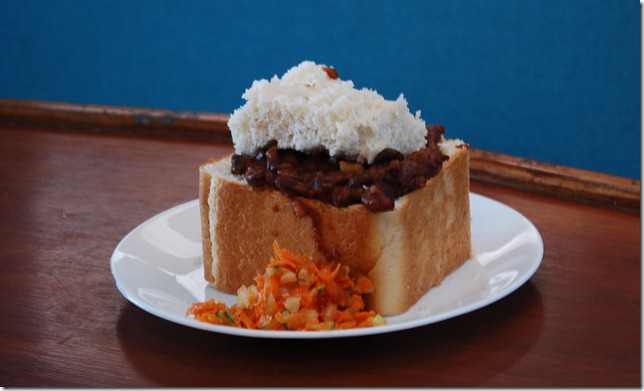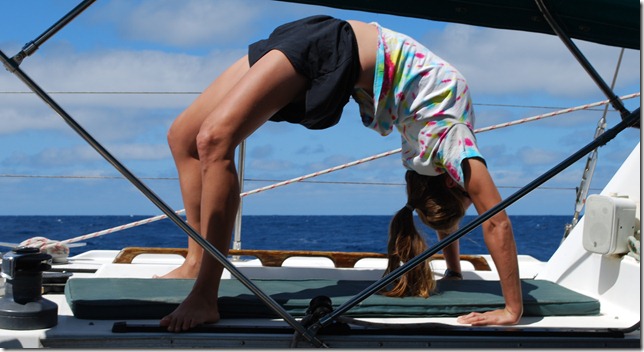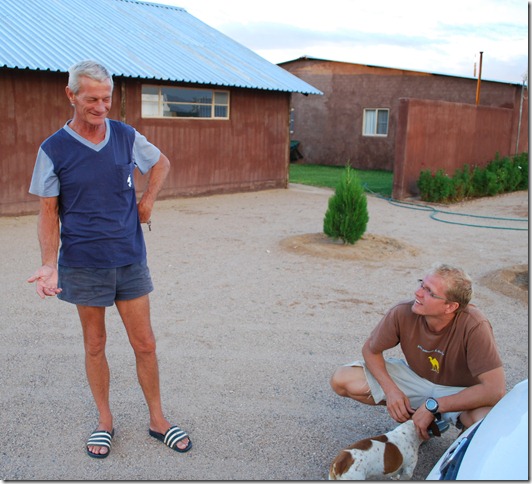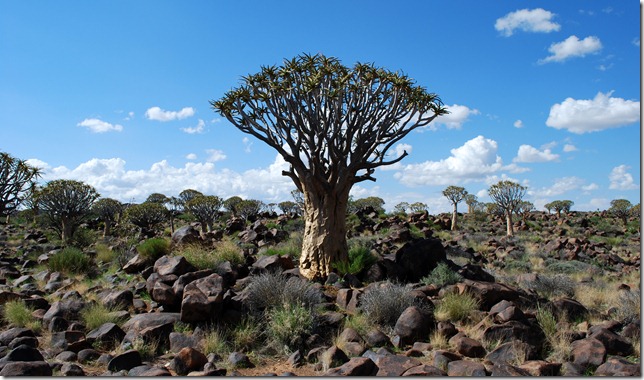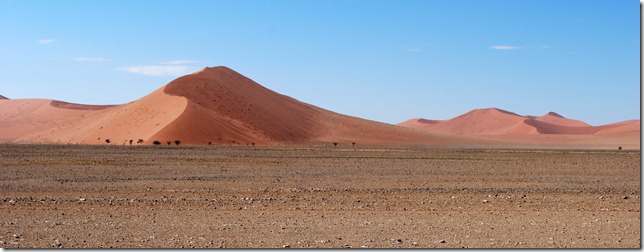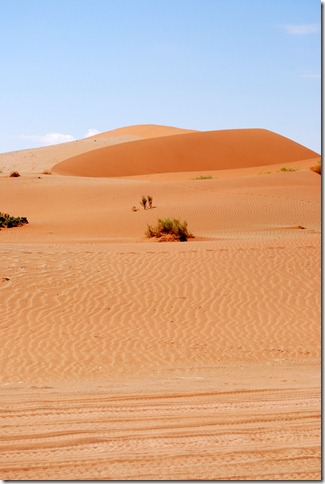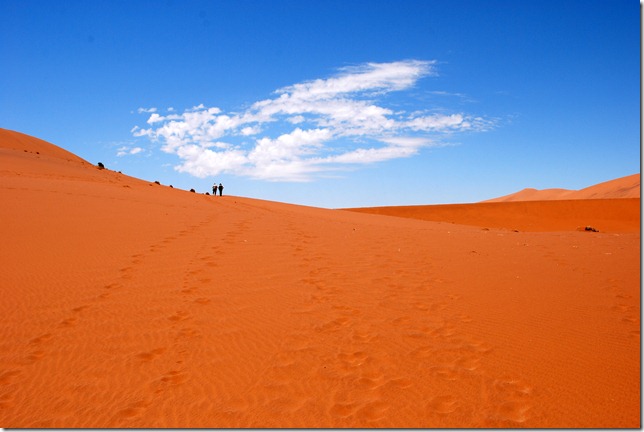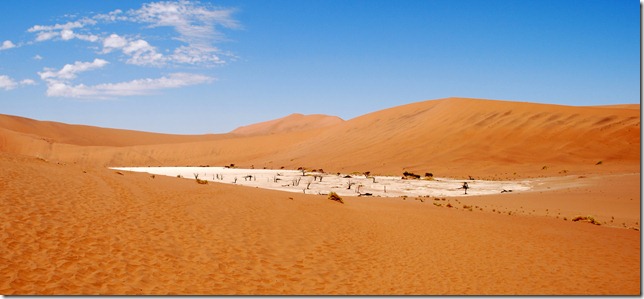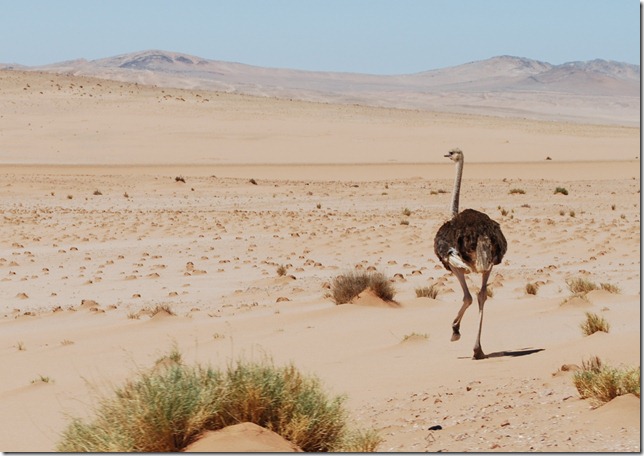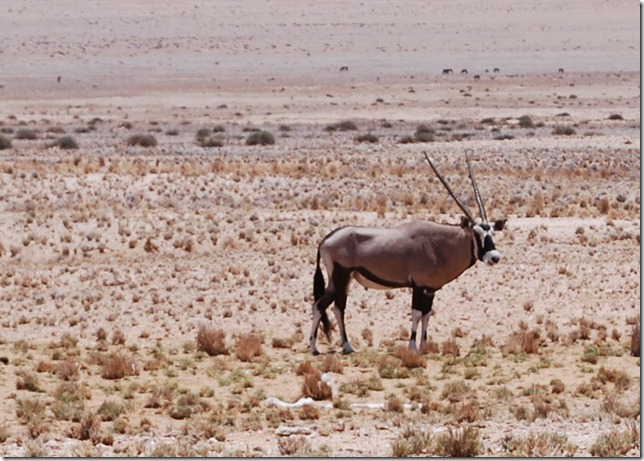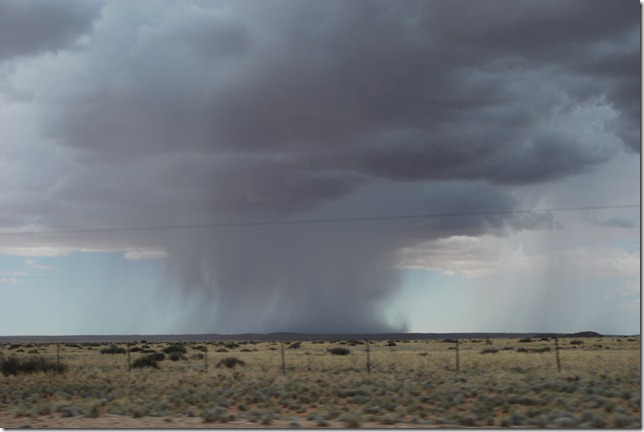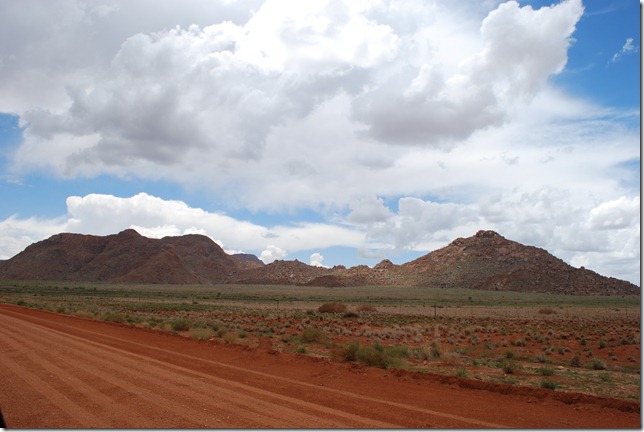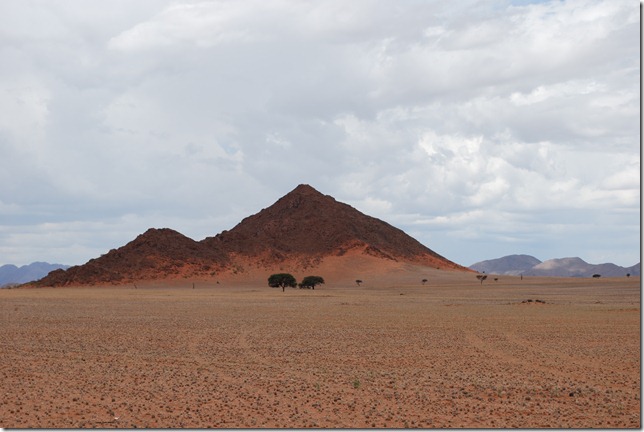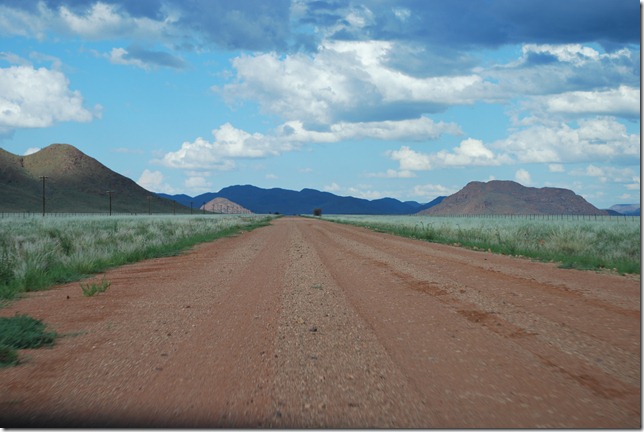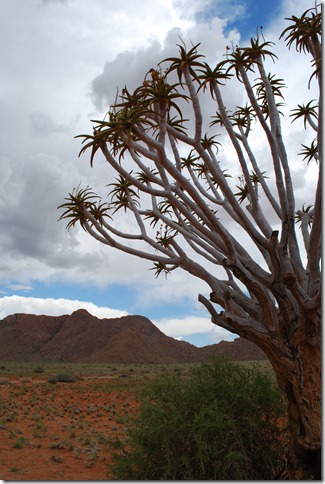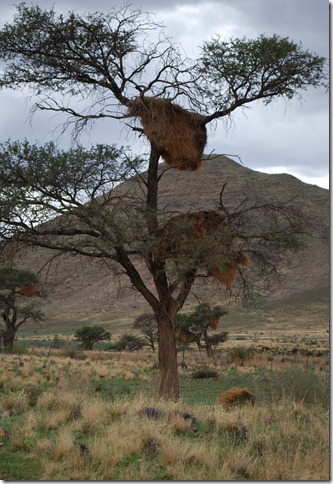Lat: 24 49.362′ S
Lon: 11 03.883′ E
When we returned from our road trip after sunset, we found ourselves facing a small problem. We were on the dock and our dinghy was behind our boat. We’d loaned it to RDJ while we were gone instead of leaving it tied up at the dock, and the other boat we know in the anchorage had locked their dinghy to the dock before leaving town on their own road trip, so had no chance of borrowing it or calling for a ride. I was half disrobed and planning to swim the few hundred feet to the boat, but I was feeling pretty chicken because of the large jellyfish we’d been seeing washed up on the beach. Sharks are one thing — they have to sort of choose to attack you, but jellyfish are another, as all you have to do is be in the same place at the same time to have a bit of a problem. While I was wavering, Tracey found a kayak paddle to borrow at the yacht club and I borrowed someone’s dinghy from the dock to go and fetch ours.
Luderitz isn’t a very common stop for yachties, but it has been pleasant and is also a really safe place compared to Mozambique and South Africa. It was fine to leave our dinghy behind the boat at night and we could walk around at night as well with no worries. The only downside to Luderitz is that the wind can be pretty intense. We were really fortunate in that although we had gale force winds on our way into the port, we never experienced the 40-60 knots winds that are a common occurrence in the anchorage. Everything we you might need for a stop is within easy walking distance and there’s even an internet cafe where the internet works most of the time.
We’re a bit behind schedule and had already spent longer than planned, so we checked out the next day for a Saturday departure and started going though the usual list — water, provisioning, internet, last hot shower, etc. Lauren and I took time for a dinner out together and then we stopped at the convivial yacht club for a final visit. A cruise ship with some fuel problems had decided to turn a typical afternoon stop into an overnight visit and so the yacht club was filled with passengers watching rugby and crew enjoying an evening out. We joined up with some of the crew and visited a couple of local night spots that were fun and friendly, but definitely had a small town feel to them. Talking to the cruise ship reminded us of how much closer we’d come to the Somali pirates than we’d wanted to by sailing through after the monsoon change. Their ship was chased by pirates in Mozambique waters this month and last month several ships were chased and one taken hostage near Bazaruto, an area we’d sailed through about halfway into our trip down the Mozambique coast. The increase in the pirate operating area has been incredible this season. When I got back to the boat, and checked email with the sat phone, we had two urgent messages from Martin on Anima. He and 20 other boats were anchored in the Maldives on the way to the Gulf of Aden, but were now deeply concerned and undecided about what to do due to the recent escalation in pirate activity. It sounds like some of them may alter course and head for South Africa, but we just heard from Martin today that he’s finally decided to join a convoy and head for Salalah, Oman. We wished him luck and will be keeping in touch until he’s safe in the Red Sea.
Before leaving, we nearly caused a riot by taking some local kids for a dinghy ride and then finally giving away all our cheap soccer balls that we’d purchased in Bali for kids in Madagascar. Like Lauren said, I guess the good thing about giving out some soccer balls is that although there aren’t enough for everyone, they’re no fun to play with by yourself. We also had an unexpected treat for lunch when Tracey cooked up a Durban-style beans bunny chow. I didn’t think I’d be having one of those again anytime soon, but I loved them in Durban, and this one was excellent as well. It took a bit of work to get the anchor loose from the thick mud in the harbor, but before long we were on our way with favorable winds.
On a bit of a side note, we ended up sailing away with only one engine. Lauren freed the port engine of fishing line our first day in Luderitz, but the starboard engine was acting pretty strangely on our arrival (enough so that I was prepared to turn and head for St. Helena if things went wrong during our arrival in gale-force winds). It’s been hard to start, fuel consumption has gone up, and it was idling at 1500 rpms instead of 850 when we came in. When I finally found the time to look at it on Saturday, I found the throttle lever on the engine seized. Unfortunately, the entire gear housing at the front of the engine would have to come off to work on it from the inside, so I was a little bummed at first. However, after a bit of WD-40, physical therapy, and hot oil splashing around the inside of the engine, I was finally able to work it loose and it now moves better than ever. Now I just have to crawl back down in the engine room and get the idle and throttle cable re-adjusted properly and we should be back to two engines. Although all the maintenance can be a chore, I definitely don’t miss the old days of owning a monohull and only having one engine to rely on.
The waters near Luderitz are teeming with seals and it didn’t take long before we were sailing near them again. They are mostly in groups of 20-40 and when they see the boat they do little spy hops in groups of up to four or so, swimming upward with enough force to push nearly half their body out of the water, head turned toward us, for a quick look as we sail by. We actually sailed right through one group of them. They stayed at the surface until we were within a few meters and then dove out of sight.
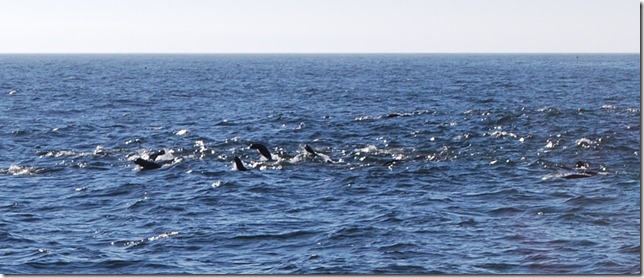 The seals are active when we’re around
The seals are active when we’re around
Yesterday morning I was treated to several groups of pilot whales and our first Atlantic flying fish on my morning watch. The day turned out to be a beautiful sunny one that reminded us how close we’re getting to the tropics. Unfortunately, it wasn’t without tragedy. We kept our large, beautiful tri-radial spinnaker up a bit too long when the wind picked up and blew it out, ripping off the entire reinforced clew. We’re already looking marginal for making Carnival in Brazil as we’d hoped to do, but hopefully our second, smaller spinnaker will be enough for us to keep our speed up in light winds. For now, we have a pleasant beam reach in calm seas under full main and jib and are enjoying shorts and T-shirts during the day. The water has turned that clear, beautiful offshore shade of blue, and this morning I woke up to Lauren in the midst of a yoga session on the deck (try that on a monohull). Now if only we could entice some fish to have a bite of our lures…
 One pilot whale blowing while another’s fin breaks the surface
One pilot whale blowing while another’s fin breaks the surface
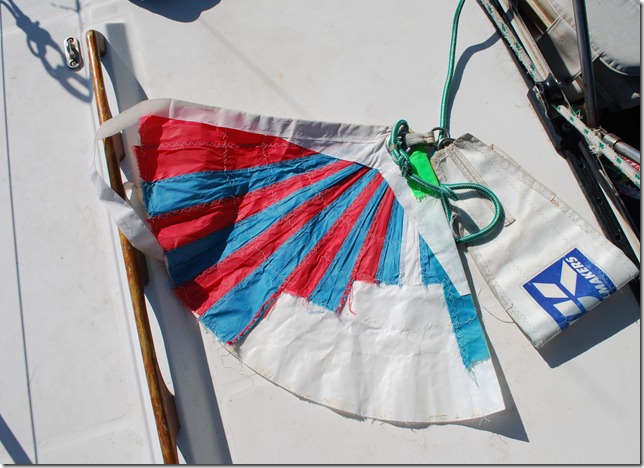 What used to be the clew (aft corner) of our large spinnaker
What used to be the clew (aft corner) of our large spinnaker
After waking up to another beautiful day in the desert, we had a quick breakfast and departed, waving goodbye to Oom Fritz as he mowed his postage stamp sized green lawn in the middle of thousands of hectares of dry desert plain (“oom” being the Afrikaans term commonly used as a polite form of address for men older than oneself and most closely translated as “uncle”).
Oom Fritz explaining to Dallas that wind is made here and then sent everywhere else!
The route back to Luderitz went past Hammerstein Lodge, a local game farm offering lodge-style accommodation, a small wildlife reserve and animal sanctuary for injured, orphaned and rescued wildlife. After being greeted by Daisy, the friendly springbok, rescued from a hit and run when she was just a calf, Dallas and Lauren relaxed in the tea garden while I went for a closer encounter with some red caracal (a type of wild cat), a couple of cheetah and a leopard.
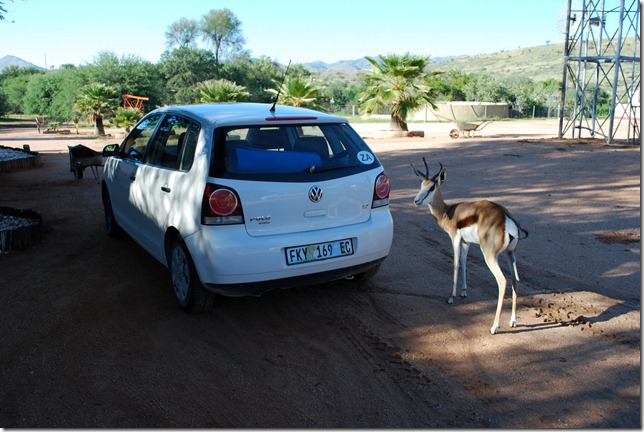 Daisy, the friendly springbok inspects the hire car
Daisy, the friendly springbok inspects the hire car
Leaving the lodge, we got back on track for the road back, choosing the most reliable route home with tarred roads as far as possible, given that enough rain had fallen in the night to render many of the roads impassable, including the one we had used the day before en route to Sossusvlei!
The route home climbed a pass to the level of the interior plateau and we were treated to some great vistas and some more sightings of birds and jackal. Just before the tarred road started again at Maltahohe, we passed some friendly locals in their horse- and donkey-drawn carts, waving as they trotted past and we noted, as the last cart disappeared in the rear-view mirror, that that made it 3 counts of animal drawn vehicle to 2 counts traffic with engines that we had passed on that road in some hours…
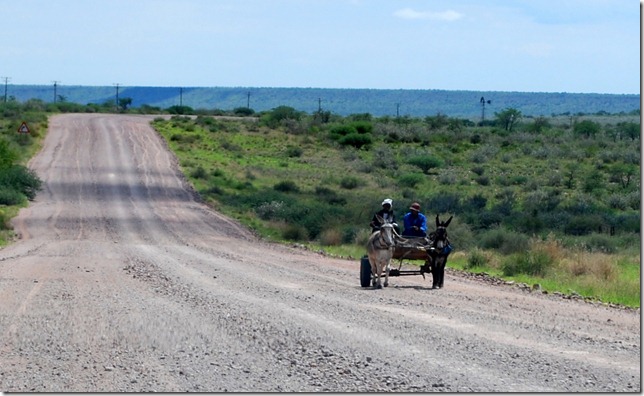 Namibia’s answer to travelling “green”
Namibia’s answer to travelling “green”
The route through to the town of Mariental and towards Keetmanshoop was more typical desert plain than we had previously seen and just before the last-mentioned town, we stopped to see the Quiver Tree forest, a group of plants, several hundred years old, which was declared a national monument in 1955. With their yellow trunks, white-grey branches and green leaves, these aloe plants make dramatic photographic subjects against the impossibly blue Namibian sky.
Thereafter a quick view of the Giant’s Playground, an area of interestingly eroded rocks, likened to the play blocks of some imaginary giants, and a dinnertime tour of rescued cheetahs at the local game farm and lodge, we hit the road again for the last leg of the journey back.
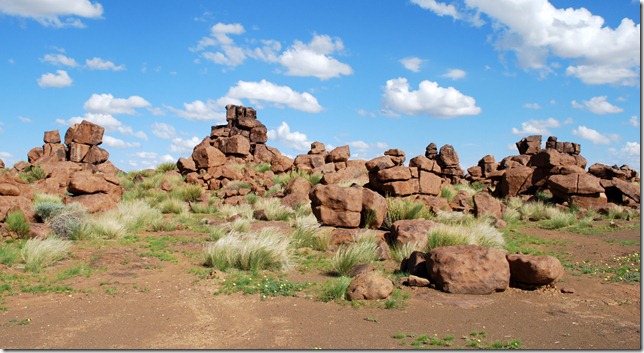 Giant’s Playground eroded rock formations
Giant’s Playground eroded rock formations
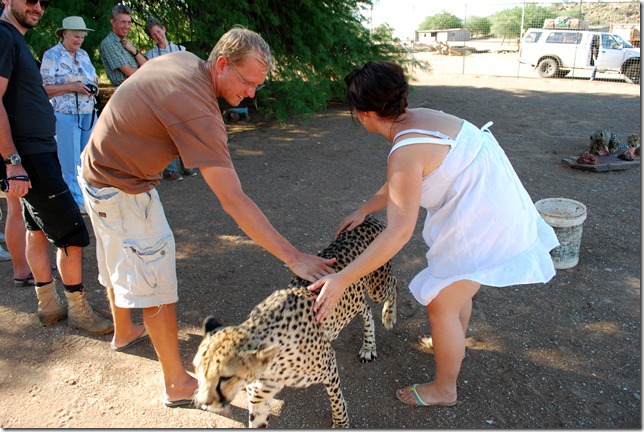 Dallas gets up close and personal with the lady in the spotted coat
Dallas gets up close and personal with the lady in the spotted coat
Descending from the plateau in the late afternoon light made for some breathtaking views of the dramatically coloured landscape before darkness finally fell as we neared Luderitz again.
The Namibian desert tour completed, we headed back to the boat, enriched by our experience of this land of big dunes and big skies.
We awoke on the morning of the 2nd at 5:30 in order to take full advantage of the day, but as the sun had not yet found its way over the mountains, we decided to rest a little more on the mattresses that Fritz had kindly lent us. The table and extra mattress that we had propped in front of the two doors of our concrete shelter had served us well in keeping out the creepy crawlers (e.g., scorpions!), and we slept reasonably well despite the heat and the occasional mozzie flying around our heads.
Around 6:00, I crawled off the mattress and began pouring charcoal into the braai in an attempt to heat some water for coffee. It took a little while, but eventually we had cups of Nescafe and Milo (a malt drink for Dallas) to accompany our cereal and powdered milk. Tracey emerged from the shelter with a plate on which were a few cookies topped with lit candles, and she and Dallas did a pretty good rendition of Happy Birthday for me as the morning sunlight reflected off the red dunes in the distance.
Packed and ready, it was time to head to the main attraction, Sossusvlei. This vast expanse of massive red sand dunes is Namibia’s 2nd most popular tourist attraction (the Etosha National Park being 1st), and I had wanted to see it ever since I saw the photos of the dunes in the brochures we picked up in Cape Town. After spending a day driving to see it, our plans were nearly thwarted as a result of rain the night before. As we approached the Sossusvlei Park, we came to an offshoot from the Tsauchab River that was running across the road with force. Fritz had told us that in these cases, one just has to wait for a couple of hours for the water to drop, but it seemed as though this one was going to take an entire day. (We later learned that the locals put a stick in the river to determine the rate at which the water is dropping.) Fortunately, we found another route and only had to cross the river-on-the-road twice when it was relatively shallow.
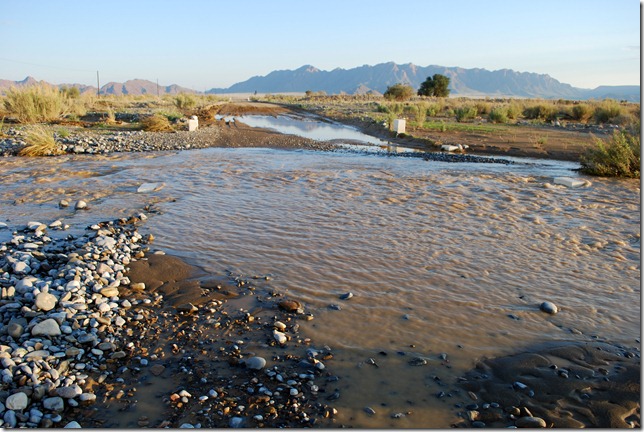 Not gonna get through this obstacle
Not gonna get through this obstacle
Once in the park, the views were astounding. Some of these dunes are over 1,000′ tall and are reported to be some of the highest in the world. Each dune has multiple crests that meet at the highest point and change shape as a result of the changing wind. The crests often form a large S running alongside the dune that is highlighted by the effects of the sun and shadows. This is but one of the visual effects that led to our impression of the place as a photographer’s dream.
Of course the most obvious and unique visual effect is the reddish hues of the dunes, ranging from salmon pink to burnt sienna to bright reddish orange depending on the sunlight and time of day. The redness is apparently the result of the higher levels of rainfall in the area relative to other parts of the desert. The rain feeds the Tsauchab River which once flowed to the sea but is now blocked by the dunes, creating a lake (“vlei”) during times of heavy rain. Over time, oxygen from the water has combined with iron in the sand, and voila! Rusty sand!
Most of the park can be viewed by car, but the last 4 kilometers before Sossusvlei itself (the lake bed) are unpaved and 4-wheel drive only. Despite the strange looks and reminders from the shuttle drivers that it was very hot (probably upper 80s), we decided to walk this bit. This gave us a chance to experience the quiet mystery of the place. Of course this also allowed us to take lots and lots of photos of the dunes as well as the various rippling effects in the sand created by the typically westerly winds.
We were lathered up with sunscreen (thanks for the 70 SPF, Santa), carried plenty of water, and were pretty comfortable during the walk with one notable exception — our feet! Note to self: when walking over two miles through the desert, flip flops may sound like a good idea, but closed-toe shoes are strongly advised! It wasn’t a big deal until we left the primary trail in search of “Deadvlei” (a permanently dried out lake bed). The markings for the path to the vlei were minimal, so we found ourselves just following in others’ potentially misguided footsteps through loose, burning sand up the side of a large dune. This is certainly an amazing experience that I could only have envisioned in reference to movies such as Star Wars or 10,000 B.C., but I must admit that at the time, I was a little preoccupied with my burning feet! I am generally pretty tolerant of pain, but this was intense, and there was no relief in sight……fortunately we were in the right place, and when we arrived at the summit of the dune, we were rewarded with a breathtaking view of the white-clay lake bed set off by the surrounding red dunes. The lake bed was empty with the exception of several dramatic looking, leafless camel-thorn trees that are said to be as much as 500 years old!
As we prepared to descend the dune, we stopped for a water break, and I couldn’t resist pouring a bit on my feet….ahhh, temporary relief! Of course this use of our drinking water was considered questionable by my traveling companions (“you know you’ve been in the desert too long when…”), but I assured them that they could have the rest of the water as I would be taking the shuttle back! It turned out that after 2+ hours, they, too, had had enough desert hiking, so after a quick look around Sossusvlei itself (not nearly as cool as Deadvlei when dried out), we headed back to our car in comfort.
One aside that I feel compelled to mention — there were several makeshift toilets set up where the cars were parked, and Dallas encouraged Tracey and I to have a look at the one designated for men. It was nothing more than an open-air tent with a row of 5 or 6 pipes coming out of the ground. I suppose that’s as practical it gets!
By 3:00, we had made our way to the park restaurant and ordered some much-needed refreshments. Shortly thereafter, the rain came. It was one of those short, intense downpours that I have experienced many times in the tropics, but it was a desert first. Not for the restaurant staff, though, as they quickly set into motion sweeping up indoor puddles and battening down the hatches.
Once we were fed and watered, we picked up a few provisions for the evening braai at the local gas station/grocery store and made a final stop at the Sesriem Canyon. Carved out by the Tsauchab River over several centuries, the narrow gorge is about 30 meters deep and is pretty impressive when standing on the edge.
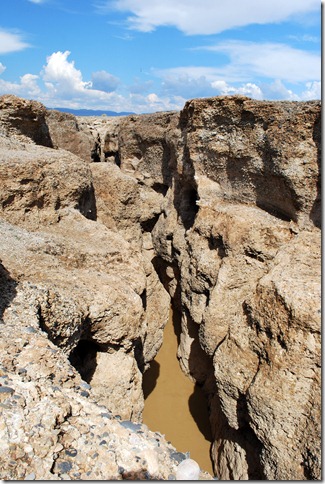 The canyon is 6 “ox-riems” (Afrikaans for ox-tails) deep
The canyon is 6 “ox-riems” (Afrikaans for ox-tails) deep
We returned to Fritz’s lodge for one last desert braai and sleep under the stars. After all of that time in the sun, I slept very well, “I promise you!” (common South African phrase). If someone would have suggested to me many years ago that I would be spending my 34th birthday in Namibia, having arrived there by sailboat, I probably would have been skeptical, but it was something I will never forget.
We really didn’t know what to expect in terms of terrain, road conditions, and wildlife when we left Kolmanskop for Sossusvlei, but we soon found out. The barren desert continued as we drove east from Kolmanskop, but we’d been driving only 5 minutes so when we spotted two wild ostriches grazing on the small tufts of growth near the side of the road. It turns out that ostriches are easily spooked, so you’re most likely to have pictures of ostrich tails as they run from the car, but we got a couple of decent shots and loved watching the ostrich run with its characteristic bouncing lanky trot, head and body swaying the each long-legged step.
A bit further on we came to feral desert horses. How a bunch of wild horses came to be living in the Namibian desert isn’t exactly clear, but one theory is that they were left to fend for themselves by German or South African soldiers that were on the move and could no longer feed or care for them. They’ve apparently lived there for close to 100 years and only in the last 15 years have they been able to benefit from a small watering hole that was built for them. When we stopped, we got to see several ostriches and a beautiful oryx (gemsbok in Afrikaans) hanging out in the vicinity of the watering hole as well.
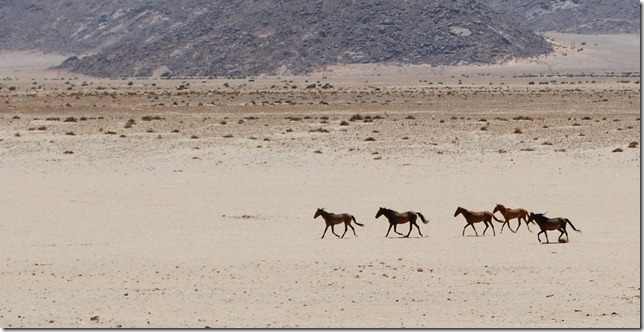 Feral horses coming in for a drink
Feral horses coming in for a drink
After only an hour we left the tarred road (only a couple exist in Namibia) and turned our little VW onto a dirt road and headed north. The dirt roads here are completely different than in the US in several ways. One difference is that they’re much wider (at least 3 “lanes” wide) and are generally well maintained by road graders. The other big difference is that bridges are completely absent. In most cases the temporary rivers created by the rains during the rainy season just run right across the road, or to put it more accurately, the road is occasionally replaced by a riverbed crossing. In some cases the riverbed has been paved over with two lanes of concrete to make crossing easier, but only in a few spots. We’re in the rainy season now, and as we started driving north we could see rainstorms dumping water on the dry ground as they moved quickly along. Rains in the desert are short-lived, typically lasting only a few minutes, but can be pretty intense. As we drove I started to understand why the rental car agent had so much to say about flat tires.
The farther north we went, the more beautiful the terrain became – red dunes to the west, rugged mountains and plateaus to the east, and north, and large flat valleys, or floors, that were more or less covered with grasses, shrubs, and trees, depending on the amount of rain that they had seen. Namibia is a land of incredibly beautiful colors and textures, especially in the light of sunrise or sunset. It’s difficult to describe how many different colors and shades you see and how beautifully they complement each other. Greens, reds, yellows, browns, and purples from dunes, deserts sands, mountains, living, dead, and dying plants, and exposed and eroded mountain strata stretched over the full field of view. There were more exclamations about the beauty of the landscape than during any other drive we’ve taken. The magnitude of the visible distances as well as the differing types of terrain and variety of colors we something we’d never seen before.
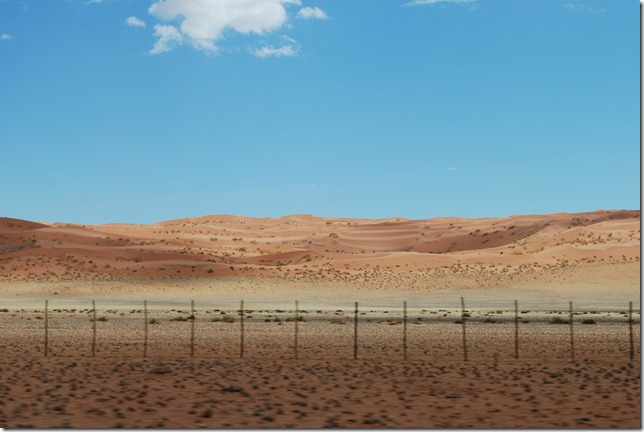 Our first glimpse of the red dunes
Our first glimpse of the red dunes
We were making good time until we stopped for fuel and were warned that we should take a different route than the one we were planning to avoid a section of road that was in very poor repair and guaranteed to flat a couple of tires. Unfortunately, the detour involved a large, soft, dry riverbed. The local that described the riverbed told us that there would be a steep descent into the riverbed followed by a large, soft run though sand. His instructions were to stop and the edge, then “put foot” and try to speed across. When we finally reached the riverbed, we got out and scouted a path then promptly banged the frame of the car coming down the steep incline and got stuck in the sand. Thoughts of spending the night at the nearby farm or having to arrange a two out were running though my head, but luckily we weren’t the first to get stuck there and there and Tracey soon spotted a few pieces of particle board laying. We were able to slip the particle board under the tires and after several attempts and a bit of “putting foot” our little white conveyance finally pulled through to the other side.
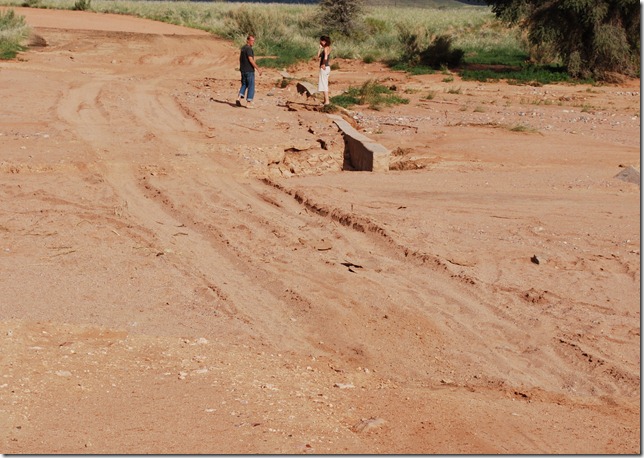 Scouting out the riverbed (didn’t do any good, btw)
Scouting out the riverbed (didn’t do any good, btw)
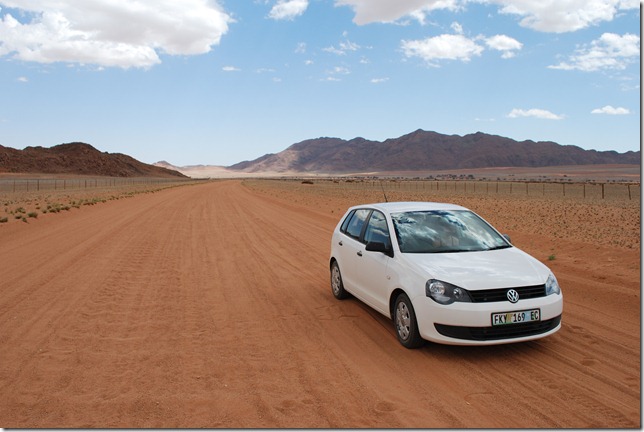 The VW Polo is now certified for off-roading
The VW Polo is now certified for off-roading
Aside from all of the natural beauty, the rest of the drive was pretty uneventful, although did see lots of springbok, a couple jackals, and lots of massive community weaver nests. The weaver birds build huge shared nests like apartment complexes that start to dwarf the hosting tree. Each group seems to be trying to outdo the next with the size of their nest. Some were so large that they looked like they must be killing the tree, and someone had helped mother nature by propping up a log to support a tree branch with a particularly large nest far out on it.
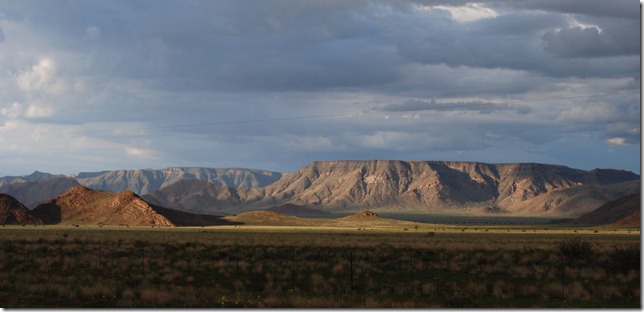 Plateaus drenched in setting sunlight
Plateaus drenched in setting sunlight
We were able to reach our destination just before sunset, but we hadn’t worked out any accommodation for the evening yet. Luckily for us, we really scored when we stopped and met Fritz at the Sossusvlei Campsite. He was a former South African police officer who had moved to Namibia after Mandela came to power. He was a real character – funny, kind, and very accommodating. Not only were the rates cheap, but he also had a few mattresses we could use for free, a swimming pool fed from his excellent well, cold beer, and hot water. The campsites here are a bit different than in the US. Each includes a kitchen area, shower, regular toilet, braai facilities, and garage-style parking to protect you from the strong desert winds. After killing a scorpion on a counter and a large sinister-looking spider in the garage area, we were glad to be sleeping on mattresses inside instead of the dirt outside, even if there weren’t any doors separating inside from outside.
Believe it or not, we’ve been in Namibia 4 days now and still haven’t been online. The internet wasn’t working in town the day we arrived and the road trip we just returned from didn’t give us the opportunity to get on line either, but hopefully tomorrow we’ll have some pictures of Namibia to put up. For now, you’ll have to take our word for us that Namibia has one of the most stunning landscapes we’ve ever seen.
To backtrack just a little bit, we dropped anchor on Sunday evening and made it into the yacht club before sunset where we intended to have a shower and then head back to the boat for dinner and a full night’s sleep. Unfortunately, the yacht club bar was filled with tuna fishing boat captains and they lived up to their reputation. We’d didn’t make it back to the boat until we’d been the recipients of about half a dozen rounds on Captain DJ.
We woke up early and full of energy after good night’s sleep and had another nice surprise. The French guys on RDJ were just entering the anchorage. We were glad to see them and it meant we’d won a race for the first time. Romain had bet me 4 rounds of beers for all crew on board that they would beat us to Luderitz. Even though they’re a heavy steel monohull, they’re able to retrieve ocean current information at sea, we’re not all that fast, and I’m generally pretty conservative (or lazy) about the amount of sail we have up, so I wasn’t holding out any hope of beating them. As it turns out, they were able to find a good current and had a higher average speed, but they had to go so far offshore to find it that we beat them in. Lauren volunteered to make crepes for everyone for breakfast so I ferried them over and we all enjoyed a 5 star crepe breakfast and had a good laugh at how much better Lauren was at making crepes (her first time) than the French captain.
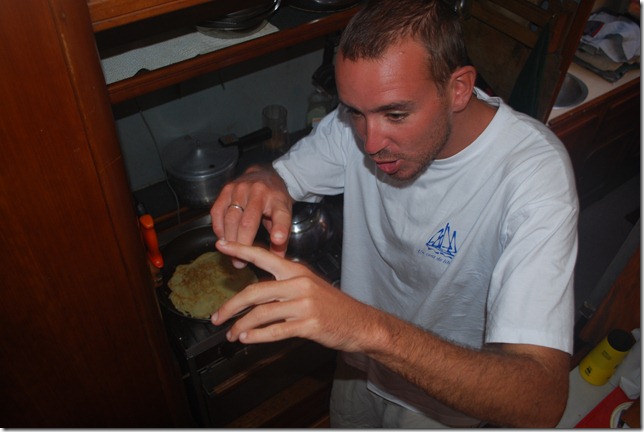 Romain explaining that round crepes are boring and crepes in the shape of countries are much cooler
Romain explaining that round crepes are boring and crepes in the shape of countries are much cooler
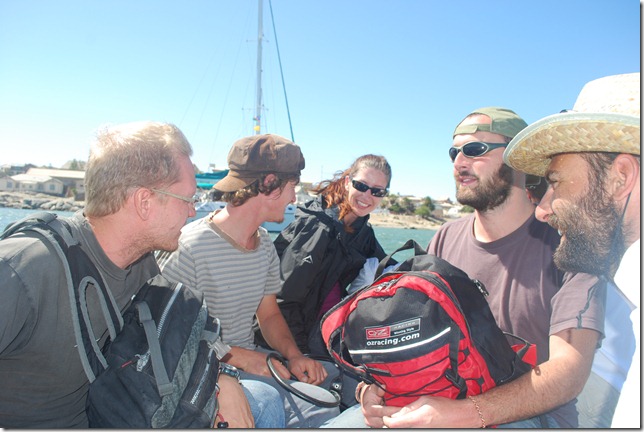 RDJ doesn’t have an engine for their dinghy, so we were the taxi in often windy Luderitz
RDJ doesn’t have an engine for their dinghy, so we were the taxi in often windy Luderitz
The rest of the day was spent checking in (quick, easy and very, very friendly although we were boarded to check for stowaways), getting a local SIM card, and trying to find a rental car. There’s no longer any airline service to Luderitz and the new railway here isn’t finished yet, so although there are both Avis and Budget in town, they often don’t have any cars available as there isn’t much demand. We were hoping to get a 4×4 and travel with RDJ but we ended up with the only rental available in town — a small 4-door VW hatchback so we travelled on our own while RDJ got a head start on the passage to St. Helena. RDJ had us over for a farewell dinner and treated us to several delicious tuna dishes courtesy of the large tuna they hooked on the way here.
Early Tuesday morning I picked up the rental car and we loaded it up with food and a few meager camping supplies. Being pretty budget-minded, we were planning to skip the expensive lodges and go for sleeping under the stars or in the car at a campsite. Our destination was Sossusvlei, home to beautiful red sand deserts that boast the largest dunes in the world. The 6 months of driving on the "wrong" side of the road came in handy as they do the same here and the car was a manual.
Our first stop was Kolmanskop, a diamond mining ghosttown in the desert just out of town. In 1908, a German railway inspector discovered the first diamond in this area. Southwest Africa, as Namibia used to be called, was a former German colony that was given to South Africa to administer after World War II and was the last African state to gain independence. At the time, the Germans were building a railroad to move troops and equipment from the port of Luderitz to points farther inland, but diamond mining soon became much more important. Even today large portions of the southern coastal region of Namibia is completely off-limits due to diamond deposits and mining and even the waters offshore are restricted as the sea bed is being mined for diamonds.
When they were first discovered, the diamond fields near Kolmanskop were some of the richest in the world — at one point the original diamond discoverer August Stauch sat down and picked up 421 diamonds in one spot. There were so many laying on the desert surface that workers would make a line and lay on their stomachs on the ground, inching forward as they searched the sand in front of them. Their mouths were covered with cloth masks while they worked to prevent them from swallowing diamonds. To prevent theft by workers, the 800 indigenous workers at the mine were required to sign on to work for 2 years without ever leaving the mine grounds. Two weeks before their contract was up, they were transferred to a quarantine facility where they were given healthy doses of Castor oil and used latrines with mesh screens that would catch diamonds while passing waste. Because of their familiarity with the site they were only allowed to work one 2-year term.
The profits from the mine allowed a pretty extravagant lifestyle for the German mine managers and workers. They had a bowling alley, fresh water shipped in from Cape Town, an ice factory, a butcher, a swimming pool, a casino and entertainment hall that hosted world-class performers, a small train that acted as a public transit and ice delivery vehicle, and a hospital with the first X-ray machine in southern Africa (very useful for spotting hidden or swallowed diamonds).
When diamond deposits were found farther south that were more cost effective to mine, the boom ended and Kolmanskop eventually became a ghosttown. The dry desert conditions and strong German construction have left most of the buildings weathered but still standing, while the desert winds and sands have surrounded and in some cases partially filled them with sand drifts. Today they’re characterized by a picturesque and surreal group of decaying former mansions adrift in a sea of sand.
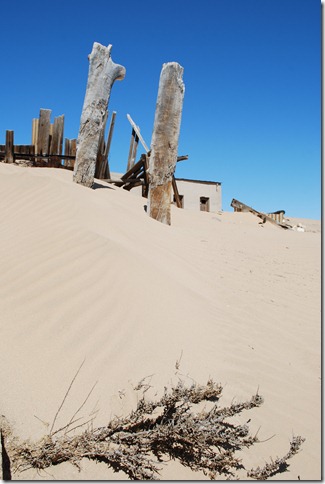 A barren but beautiful landscape
A barren but beautiful landscape
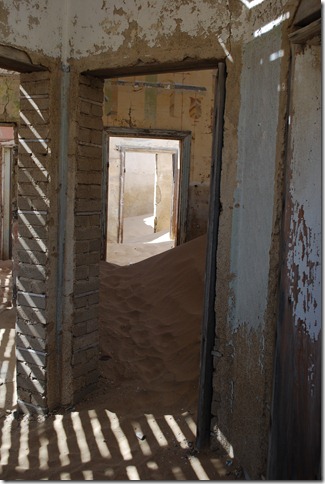 Sand fills many of the old mansions
Sand fills many of the old mansions
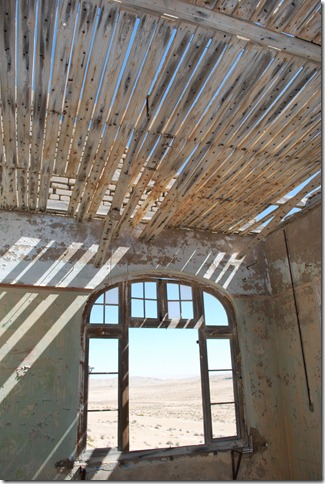 The houses are fun to explore, but are definitely “Enter at your own risk”
The houses are fun to explore, but are definitely “Enter at your own risk”
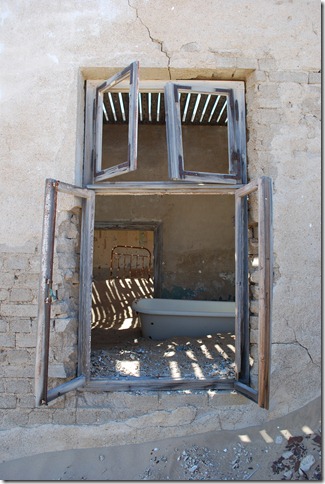 Apparently bathtubs aren’t in demand in the desert. Most were still there.
Apparently bathtubs aren’t in demand in the desert. Most were still there.
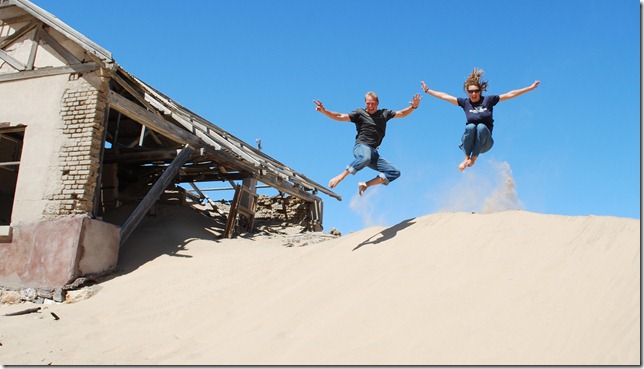 Adding a little life to the ghost town (thanks to Tracey for the pic idea)
Adding a little life to the ghost town (thanks to Tracey for the pic idea)
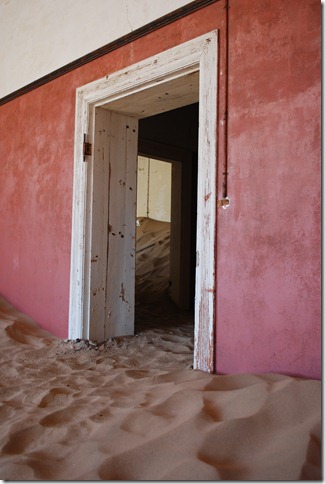 Even the paint and wall paper are still intact
Even the paint and wall paper are still intact
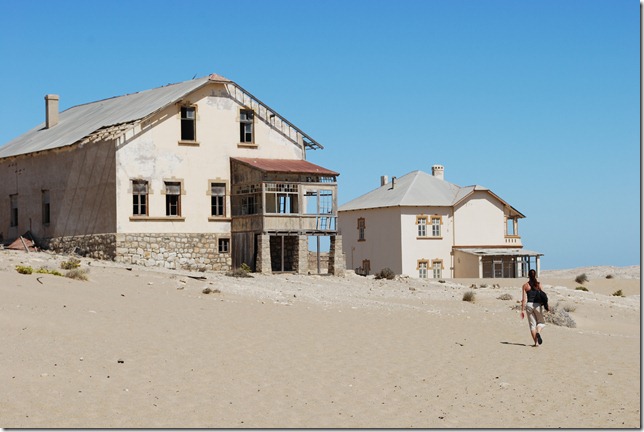 The building on the right has been renovated, but “Millionaire’s Avenue” is pretty dusty these days
The building on the right has been renovated, but “Millionaire’s Avenue” is pretty dusty these days
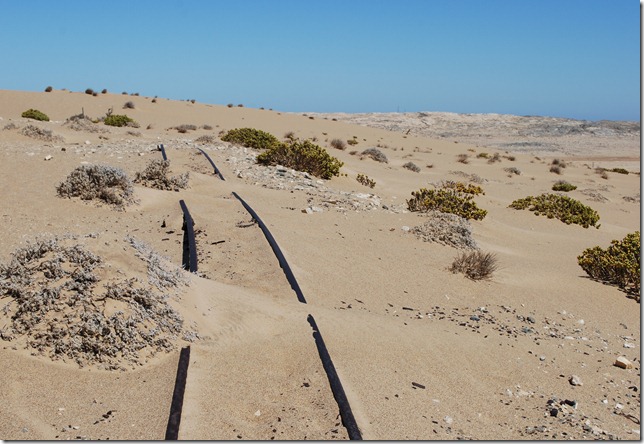 The seems to be the fate of many things in the desert…
The seems to be the fate of many things in the desert…
Our drive north to Sossusvlei as well as the rest of the road trip was nothing short of amazing, but that’s going to have to wait for tomorrow’s blog…


